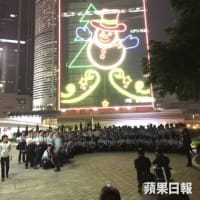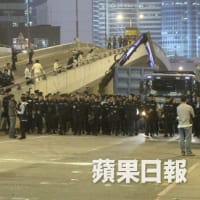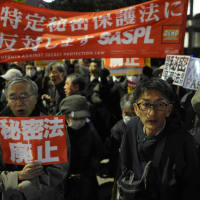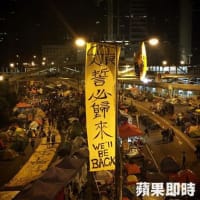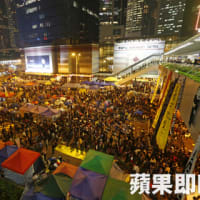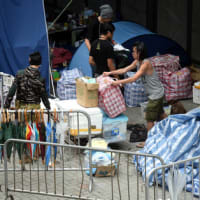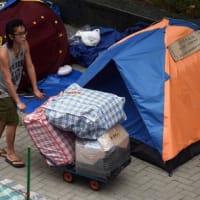Hong Kong Democracy Protest

31 ASSOCIATED PRESS
Pro-democracy activists surround and protect their tent as residents and pro-Beijing supporters threaten to tear it down in Kowloon's crowded Mong Kok district, Friday, Oct. 3, 2014 in Hong Kong. Clashes broke out Friday as Hong Kong residents and pro-Beijing supporters tried to force pro-democracy activists from the streets they were occupying, reviving the possibility that the weeklong standoff could turn violent despite and attempt by the city's leader to defuse the situation. (AP Photo/Wong Maye-E)
In Causeway Bay, a major shopping area that has also been occupied by protesters, groups of young men in face masks were forced away from the protesters by police.
Hong Kong's top civil servant, Chief Secretary Carrie Lam, said Friday she had begun organising the talks with the protesters, who have continued their sit-ins after Leung rejected their calls to resign.
"I am indeed very concerned about the clashes we have seen in the streets," Lam said.
"Sentiments are running high and there is a high chance of conflict on the streets," she said. "So I am urging protesters who have been occupying parts of the territory to consider retreating ... so that the police can restore law and order."
"I would like to appeal to members of the public that they should observe the laws of Hong Kong when they are expressing their views," police spokesman Steve Hui said when asked about the confrontation in Mong Kok, a working class area far from the main protest site in downtown Hong Kong, the Admiralty area near the territory's government headquarters.
Benny Tai, leader of the broader pro-democracy movement Occupy Central With Love and Peace issued a public call for all protesters to shift back to Admiralty where they began their protests last weekend. He said the group was confident they could guarantee the protesters' safety if they moved back to that area.
The protests, led mostly by university students, have been in the streets since last Friday, pushing for the Chinese government to reverse its recent decision requiring a mostly pro-Beijing committee approve candidates for Hong Kong's first election to choose the territory's leader in 2017. The demonstrators want open nominations.
The protests are the biggest challenge to Beijing's authority since China took control of the former British colony in 1997.
Student protesters had threatened to surround or occupy government buildings if the city's chief executive, Leung Chun-ying, did not step down by Thursday, and police had warned of serious consequences if they did that. Late Thursday, Leung held a news conference to offer the talks, but said "I will not resign."
Some who are sympathetic to the protesters' demands for wider political reforms complained the police were not doing enough to protect the demonstrators.
"We saw people with no uniforms in Causeway Bay and Mong Kok attack protesters and take away their belongings," said Cyd Ho, vice-chairwoman of the Labor Party.
"Police have the duty to safeguard peaceful demonstrations by Hong Kong citizens," Ho said. "If police do not intervene this sets a dangerous precedent ... that if people are unhappy with protesters they can attack them with impunity."
But some Hong Kong residents complained that the protests were undermining their livelihoods.
"It affected my company, a perfume business, to deliver goods in the area," said Ken Lai in the bustling Causeway Bay neighborhood. "I really dislike the fact that they occupied so many areas, all scattered around the city. I'm a Hong Konger too. The occupiers don't represent all of us."
A front-page editorial Friday in the People's Daily newspaper, published by China's ruling Communist Party, underlined the leadership's unwillingness to negotiate changes to its August decision.
参考source:http://www.huffingtonpost.co.uk/2014/10/03/hong-kong-protest-pictures_n_5926578.html













